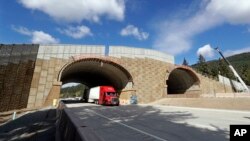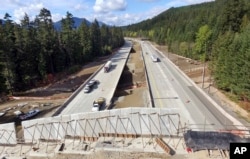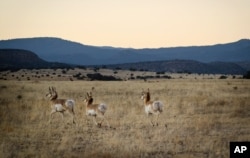In the U.S. state of Washington, a road called Interstate 90 cuts through a wild, mountainous area to reach the city of Seattle. For the area’s many kinds of animals, the busy highway greatly limits their movements. Crossing I-90 – as the road is called – is a risky but sometimes necessary act. But soon, animals will have a safer choice for crossing the road. They will be able to go above it.
Jen Watkins is with Washington’s Conservation Northwest organization. She said, “Everything from an elk down to a small salamander, they need to move to find food, to find mates, to find new places to live as their populations expand or just when conditions change, like a fire breaks out.”
To help the animals, the state is finishing work on its largest-ever wildlife bridge. The 11-meter-tall, 20-meter-wide structure begins in the forest. It forms two arches above the highway, one for each direction of traffic.
Workers are adding fencing and plants to help guide the animals across the bridge. Two-meter-thick walls will help block noise from vehicles below.
Scientists chose the area because it is within a natural migration path for some animals.
At least one animal has already used the bridge. Washington’s Transportation Department tweeted last week that a wildlife camera captured a video of a coyote running over Interstate 90 on the new structure. The agency wrote, “Excited to see what other species cross!”
More crossings needed?
The I-90 bridge is part of a growing number of wildlife crossings across the United States. Some are fences, some are overland bridges, and some are underpasses. They all aim to keep drivers and animals away from each other.
A 2008 U.S. Transportation Department study found crashes between animals and humans rose year by year. The accidents made up about 5 percent of all crashes nationally, and, at the time, cost the economy about $8 billion. Such costs come from car repairs, emergency room visits and removal of the dead animals on roads.
Collisions between animals and drivers are rarely deadly to people. But they are often deadly to wildlife. The 2008 study also found that 21 endangered or threatened species in the U.S. are affected by vehicle hits.
In Canada’s Banff National Park, studies have found that bridges, underpasses and fencing reduce the area’s animal-driver collisions by 80 percent.
And in the western U.S. state of Wyoming, crossing points and fencing built for a migration of North American pronghorns helped reduce animal-driver crashes by 85 percent.
Most of the wildlife bridges are in western states. But experts have noted many other areas that have a need for such paths.
Jen Watkins, whose organization has helped campaign for animal crossings, says finding money for more crossings is “the number-one obstacle.”
Patty Garvey-Darda of the U.S. Forest Service has worked on the I-90 crossing from the start of the project. She says the $6- million bridge will one day pay for itself because the highway will not have to be fully or partly closed each time a large animal is struck.
Garvey-Darda said, “If you shut down Interstate 90, you shut down interstate commerce.”
I’m Jonathan Evans.
The Associated Press reported this story. Ashley Thompson adapted it for VOA Learning English. Kelly Jean Kelly was the editor.
________________________________________________________________
Words in This Story
highway - n. a main road that connects cities, towns, etc.
elk - n. a large kind of North American deer with big antlers
salamander - n. a small animal that looks like a lizard with smooth skin and that lives both on land and in water
traffic - n. all the vehicles driving along a certain road or in a certain area
arch - n. a usually curved part of a structure that is over an opening and that supports a wall or other weight above the opening
commerce - n. activities that relate to the buying and selling of goods and services
endangered - adj. used to describe a type of animal or plant that has become very rare and that could die out completely
pronghorn - n. a large animal of western North America that looks like an antelope
obstacle - n. something that makes it difficult to do something











